sek·shoo·a·luh·tree
Tree Love : Sexual Divergence of Trees
This tour is meant to teach us about the reproductive strategies and sexual diversity of trees. Trees have existed for hundreds of millions of years. Compared to us, trees have been spreading their seed on Earth for at least 60 times longer than humans have existed. With that in mind, it isn’t surprising that in all that spare time, they’ve developed reproductive and sexual habits that are wildly more complex than most of us realize! Today we’ll be exploring the basic biology of a few of the intimate identities of the trees around us.
Begin this self-guided tour by locating the Chinees Pistache tree on the west side of Communications Building. Locate the Communications Building using the Campus Map.
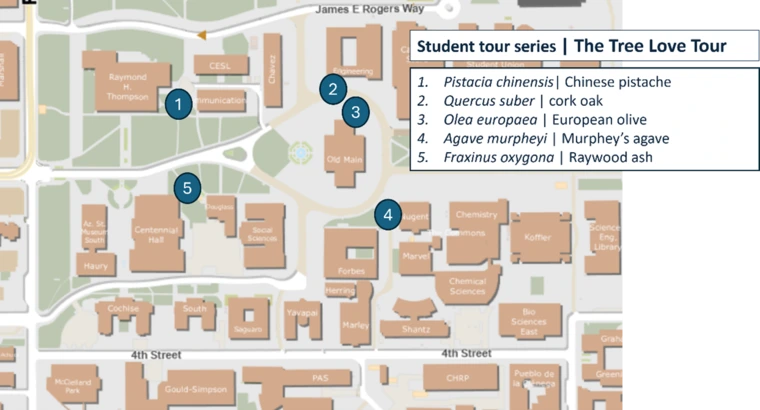
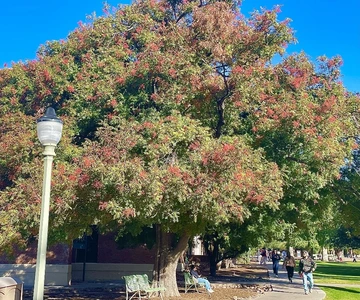
Image of the Chinese pistache on campus
The Chinese Pistache is a dioecious tree. Dioecious refers to a plant that typically comes in one of two flavors: male or female. “Dioecious” comes from the Greek “di-,” meaning two, and “oekos,” (EE-kos) meaning house, put together to explain how each gender is housed in its own tree. Dioecious trees can be likened to a cisgender, heterosexual person; each individual is only one gender and they prefer to reproduce with the opposite sex.
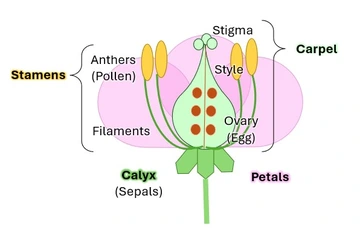
Diagram of the four parts of a flower: Petals, Calyx, Stamen, and Carpel
Trees that are dioecious have different flowers on different trees, so to help you understand a bit more about a flower, let’s talk about the four defining characteristics or traits that flowers may have.
- I’m sure we’re all familiar with petals! Those are usually the most obvious parts of a flower. They tend to be gorgeous, delicate, and brightly colored; they sometimes have pleasant aromas; and they’re meant to attract pollinators.
Just under the petals is the calyx. This area is usually made up of sepals, which are almost like early petals. They form first, are leaf-like, and serve to protect the developing bud before it opens. Once the flower blooms, sepals get to be the fun under-bits below the flower.
So the first two parts are the petals and the calyx, but the other two get into the steamy stuff…
- Near the center of a flower you might find stamens. This would be the “male” area of the flower, which often consists of parts called filaments that hold up anthers where pollen is produced. Pollen – that stuff that fills the air, gets in our noses, and bothers our sinuses each spring – contains the male gamete, or sperm cells, of a plant.
Last but not least, we have the carpel, usually in the very middle of a flower. Within the carpel is the ovary – where the female gamete, or egg cell, is produced. This is often the most protected and important part of a flower, because it usually holds only one egg per ovule, and the survival of the plant’s genome could rely on that one cell (whereas pollen granules are extremely numerous and less important). The ovary often joins an elongated channel called the style, which ends in the stigma where pollen lands.
So that gets us to all four parts of a flower: petals, calyx, stamens, and carpels.
Because the Pistache is dioecious, each tree typically produces flowers with EITHER stamens (with male gametes) OR carpels (with female gametes) AND Pistache flowers don’t have petals. This beautiful tree happens to be female. You can most easily tell this in the springtime when the flowers are blooming, and later in the season when the fruits develop. Both male and female trees produce flowers, but only the female develop fruit.
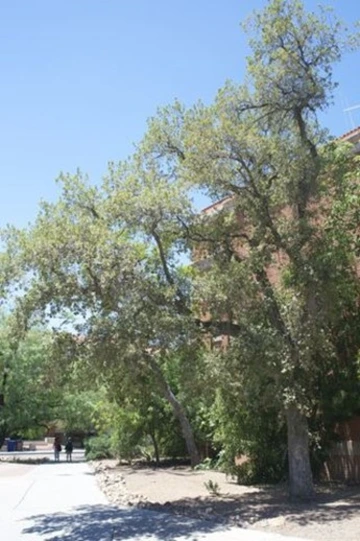
Picture of the cork oak on campus
This beautiful specimen is a wonderful tree. Quercus suber (also known as cork oak) is also one of the oldest trees on campus, and when it was planted here (sometime before 1940) it was also the biggest of its kind at the school, and possibly in all of Tucson! Not only is it a magnificent shade tree, it likes places with warm winters, tolerates drought, and prefers full-sun (which is good for a climate like ours). Additionally, it’s most known for the bark that produces a HUGE cork layer (the outer layer of a tree’s bark) and has deeply fissured wrinkles. In fact, the species of this cork oak, “suber,” is a Latin word that means “a piece of wrinkled skin.” The largest cork oak in the world grows in Portugal, where the tree is native, and was planted 1783. Its cork has been collected many times, and in 1991, it produced 2,646 pounds of raw cork (enough for over 100,000 wine bottles!) It’s also used for food, medicine, repellents, and timber, and its bark is full of tannins which are chemical compounds that play vital roles in natural (and artificial) ecosystems.
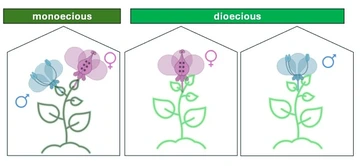
Diagram of monecious vs dioecious flowers
Unlike the Pistache, which is DIoecious, the cork oak is MONOecious, or – from the Greek root words – one housed. That is, each tree of this species has BOTH male AND female parts. Monoecious plants can be described as hermaphrodites, which refers to an organism with both reproductive organs. In humans, we also call this intersex.
Cork oak happens to be a monoecious tree that has imperfect flowers; imperfect is a term that just means the flower does not have all four of the flower characteristics we talked about earlier. In the case of this tree, it has two distinct flowers – one type with male reproductive organs and one type with female reproductive organs – even though they’re housed on the same tree. For our lovely friend here, the flowers lack all three of the characteristics other than their male or female parts, and the flowers form small, yellow chains or clusters and lack petals or sepals. After a cork oak copulates, the result is an acorn that can be planted and could eventually develop into another beautiful tree like the one before you.
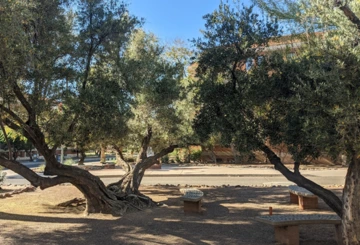
European olive tree at Old Main
European Olive trees are known for their elegance, stature, and long lives (from 300 up to 600 years). They're a symbol of peace, friendship, and divinity. Olive is an ancient tree that has been utilized for food, medicine, cosmetics, furniture, building, and more for over 5,000 years. Olives are also part of many of the world’s largest religions because of their spirituality of hope and renewal.
On campus, we have an extensive collection of olives concentrated along the Historic District walk just west of the museum, which Prof Robert Forbes began as a trial for agriculture in Arizona in the 1890s. He wanted to see if foreign plant life (like these Mediterranean olives) would survive the rather harsh desert climate of Tucson. It seems that this experiment was successful, because over 120 years later, they’re still here (and will hopefully be here for 400 more). They provide beauty, and most of all: shade! They bear innumerous fruits that are pleasant to look at… but not so fun to step on. The olives shouldn’t be eaten off of the trees, but can be cured or pressed, yielding edible olives or olive oil.
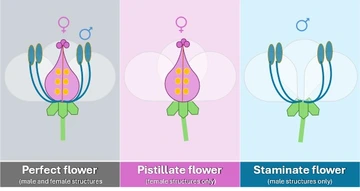
Diagram depicting the difference between a Perfect Flower and Imperfect Flowers (Pistillate and Staminate)
On the subject of fruitiness…. Olives happen to be another example of a monoecious tree. BUT, in the case of the olive, its male and female reproductive organs exist on the same flower. While Cork Oak’s flowers are called “imperfect” because they lack some of the traits of flowers, Olive flowers have both sexes on the same flower in addition to petals and sepals, so they are considered “perfect” flowers. Perfect flowers can be called many things. In addition to hermaphroditic flowers, they’re sometimes called cosexual or bisexual.
Another word used in relation to olive trees’ sex life is “polyamorous,” which is just a spicy way to say it can have both bisexual flowers (male and female parts) and single sex flowers (in the case of olive trees, usually male).
Monoecious trees have both parts, but they don’t all self-pollinate. Some prefer pollen of another tree of the same species in order to successfully turn into a fruit and promote genetic diversity. That being said, there are a lot of monoecious trees that DO have the ability to self-pollinate. European olive is one of those trees, and pollen from a flower on the tree does have the ability to fertilize a flower on the same tree. (After all, if you lived that long, you’d find new ways to play with yourself too…) Even though olive trees can self-pollinate, trees that are self-pollinating tend to have a larger yield if pollinated with a second tree.
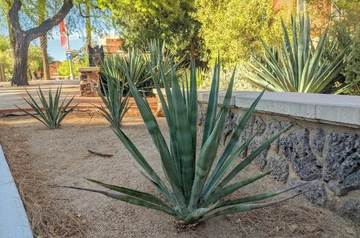
Agave murpheyi west of the Nugent Bldg.
This is Agave murpheyi. Agaves aren’t trees, but they are an extremely important woody plant that dates back millennia - significance for food, tools, and cultural traditions. They’re a symbol of resilience, health, and transformation and played a vital role in the survival of ancient Mesoamerican peoples, who were also masters of agriculture. There are sites near Tucson and Marana with remnants of what would equate to modern plant laboratories, and around those laboratories you can often find plants that were bred and developed there. One of those plants is Agave murpheyi, which can be found at a local site joined by a few of its other man-made hybrid relatives. Agave murpheyi is thought to have been cultivated by ancient Hohokam and was grown for food and fiber. Murphey’s Agave are “highly safeguarded” under the Arizona Native Plant Law, which was enacted to protect rare and culturally significant plants. Being highly safeguarded means Agave Murpheyi is protected from damage or removal.

Diagram showing two versions of embryo formation: top row depicts normal sexual embryo formation and bottom row shows apomictic embryo formation
Being a hybrid means that Murphey’s Agave was made by crossing two other species (Agave palmeri and Agave vivipara). One thing to note about romantic pairing in plants is that the parents genes don’t always…work well together. If they are too dissimilar, reproduction will fail! Nature has a funny way of being able to deal with reproductive hiccups, and in the case of some plants like Agave murpheyi, apomixis evolved. Apomixis is a form of reproduction that is asexual, meaning that a plant can produce a seed (or in Murpheyi’s case) without fertilization. A surprising number of plants evolved this ability! (A few examples are hawthorns, dandelions, grasses, and even some types or roses!) Apomixis usually evolves in response to threat of sexual sterility, and is a way for the seed to develop without (or sometimes in spite of) fertilization. Instead of normally producing a female gametophyte that can be fertilized, the egg cell turns into an embryo that results in a seed. Agaves also have the ability to reproduce asexually via underground stems called rhizomes to produce a new plant, essentially propagating a new plant from the mother. (That being said, Murpheyi do produce pollen, and they can reproduce sexually as well.)
In addition to apomixis, Murpheyi also practices vivipary. Vivipary means that a seed or bulbil germinates and begins to grow while STILL attached to the mother plant! Now, vivipary is a funny word, but you might have heard me say something similar a few minutes ago. One of the two species that Murpheyi was hybridized from was Agave vivipara, which was named for this trait of, essentially, giving birth to live young. This turns out to be quite practical, especially in the case of agaves in the Sonoran Desert… Because they begin to grow while still attached to their mother, they can utilize resources from a much bigger and more developed plant – resources like root system, water storage, and height to protect from herbivorous critters. After they’ve grow a bit, they fall off to find their own place to take up roots, and are able to start growing with a head start.
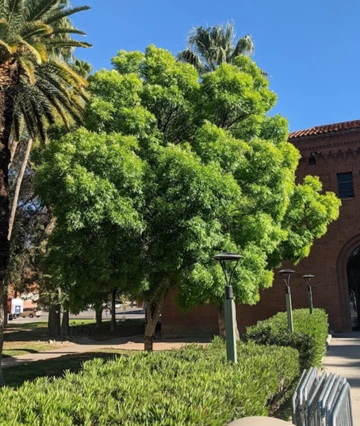
Raywood ash on campus just east of Centennial Hall
The Raywood ash is a popular ornamental tree here in North America. It gets nice and tall, usually about 40-50 feet (though potentially up to 80feet!) and produces great shade. Its leaves turn beautiful shades of red and purple in the fall, its bark is smooth and light grey, and it thrives in full sun. In fact, it’s earned itself the name “desert ash” and is treated like a weed in South Africa and Australia. Its flowers are small, dark red or purple, and often come in clusters of stamens, carpels, or a mix of both. That’s where ash trees get interesting…
Raywood ash is “functionally” dioecious, meaning it has male plants and female plants, but ashes are VERY fluid in their gender identity, commonly falling into trioecy (or becoming trioecious), meaning they actually have three genders: one male, one female, and one that’s a different category.
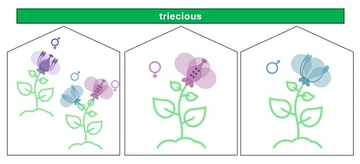
Diagram depicting triecious plants
They don’t stop at simply having third genders, either. Ash trees are also known for changing sex altogether! Some ash trees undergo partial sex changes - where only part of the tree changes its reproductive organs, while others undergo complete transitions – switching entirely from male to female, or vice versa.
This happens for all sorts of reasons. Sometimes it’s energy allocation, and trees that have enough resources are better suited to produce female flowers and seeds, because they require more energy. Or the opposite, causing a transition to male when conditions are NOT as good. Similarly environmental stressors like drought, disease, damage, or soil conditions could cause a change in sex expression. Younger trees often start as male, and as they grow older and mature may shift to female. It’s also true that the trees could shift back to male in their much later years as their energy reserves decline once again. Not to mention relationships with microbes and connections to their tree community can also play roles in sex transitions. Common Ash (Fraxinus excelsior), a relative species of our Raywood ash, is one of the most examined type of transgender trees, and studies have shown that up to 40% change sex during their life. Some of these trees alternate between male and female flowering from year to year, while others remain consistent in their sex expression.
Changing gender has advantages! Sex plasticity makes them adaptive, and it allows trees to maximize reproduction under different circumstances. Being able to shift genders also raises the production of seeds in years that are favorable, which increases genetic diversity and genetic recombination, because the trees can function in different reproductive roles. As environmental conditions become more unpredictable, trees that are able to switch gender may also have tools needed to give them an advantage for survival.


